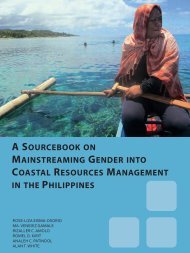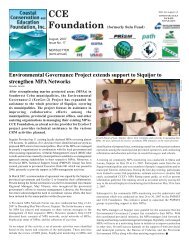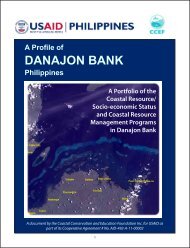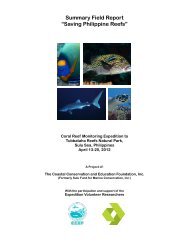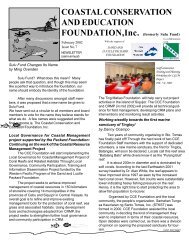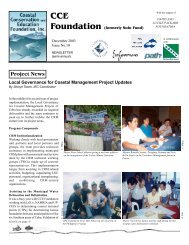Marine Protected Area Management Effectiveness: Progress and ...
Marine Protected Area Management Effectiveness: Progress and ...
Marine Protected Area Management Effectiveness: Progress and ...
Create successful ePaper yourself
Turn your PDF publications into a flip-book with our unique Google optimized e-Paper software.
Downloaded by [Alan T. White] at 14:04 18 September 2012<br />
Philippine MPA <strong>Effectiveness</strong> 517<br />
Figure 3. Percent frequency of MPAs with different rating levels within each of the top 8 identified<br />
management priority concerns in Philippine MPAs (1. Finance, 2. Alternative livelihood, 3. Community<br />
awareness, 4. Enforcement, 5. <strong>Management</strong> capacity, 6. Training, 7. Politics, 8. Gender balance).<br />
MPA Rating levels: 1 = Initiated, 2 = Established, 3 = Enforced, 4 = Sustained, 5 = Institutionalized<br />
(see Table 1).<br />
possible due to sample limitations. <strong>Management</strong> concerns 6–8 appear to be prioritized by<br />
fewer MPAs.<br />
Local Governance Capacity <strong>and</strong> MPA Coral Reef Health—Case Study<br />
Coral reef health as monitored in the MPAs of concern focuses on living substrate cover<br />
<strong>and</strong> reef fish diversity (richness), density, <strong>and</strong> biomass. In 2008, 47.5% (28) of the MPAs in<br />
the central Visayas had fair (25–49%) live hard coral (LHC); 15.2% of the MPAs had poor<br />
(0–24%) LHC; 30.5% had good (50–74%) LHC; <strong>and</strong> only 6% of the MPAs had excellent<br />
(75–100%) LHC. Overall LHC in these MPAs is relatively good compared to national<br />
averages.<br />
In contrast, 57% (54) of the MPAs had very low target fish densities. Twelve (20.4%)<br />
MPAs had moderate target fish densities <strong>and</strong> 12 MPAs good fish densities while only one<br />
MPA, Colase <strong>Marine</strong> Sanctuary in Southeast Cebu, had a high target fish density (fusiliers,<br />
surgeon fishes, <strong>and</strong> jacks that aggregate in schools). The fish data indicates heavy fishing<br />
pressure in the vicinity of the MPAs <strong>and</strong> that a few of the MPAs are most likely not strictly<br />
enforcing their no-fishing policy inside of the MPA.<br />
Out of 56 MPAs assessed for coral reef health in 2008 within the Central Visayas area,<br />
30 showed no significant changes in LHC or 53.6% MPAs in status quo. Further, 28.6%<br />
showed significant increases by 2008 <strong>and</strong> 17.1% decreased. Similarly, more than half of the<br />
56 MPAs showed no significant change for target fish densities (57.2%), 26.8% showed an<br />
increasing trend <strong>and</strong> 16% decreased by 2008. This indicates that it may take approximately<br />
5 years or more for most MPAs to have positive changes in LHC <strong>and</strong> fish densities of fishery<br />
target species (Russ et al. 2004).<br />
Twelve MPA cluster groups were identified with multivariate analyses <strong>and</strong> clustering<br />
delineating two major groups (1 <strong>and</strong> 2) with a similarity of 58 supported by MDS analysis



